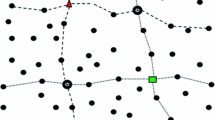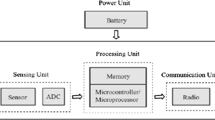Abstract
This paper focuses on the event based investigations over different data dissemination routing protocols for highly dense wireless sensor networks. Initially for the wireless sensor network domain, we analyzed data dissemination flooding and gossiping routing protocols. We etude and exemplify our proposed model for data dissemination based evaluation with Delphi random generator distribution strategy. We calculated performance metrics as sense count, transmit count, receive count and receive redundant count. At the end, simulations analysis has been carried out to prove the validity of our designed scenario.






Similar content being viewed by others
References
Estrin, D., Govindan, R., Heidemann, J., & Kumar, S. (1999). Next century challenges: Mobile networking for smart dust. In Proceedings of ACM conference mobile computing and networking, pp. 271–278.
Pottie, G. J., & Kaiser, W. (2000). Wireless sensor networks. Communications of ACM, 43, 51–58.
Haas, Z. J., & Small, T. (2006). A new networking model for biological applications of ad hoc sensor networks. IEEE/ACM Transactions on Networking, 14(1), 27–40.
Brooks, R. R., Ramanathan, P., & Sayeed, A. A. (2003). Distributed target classification and tracking in sensor networks. Proceedings of the IEEE, 91, 1163–1171.
Estrin, D., & Cerpa, A. (2004). ASCENT: Adaptive self-configurable sensor networks topologies. IEEE Transactions on Mobile Computing, 3(3), 272–285.
Clouqueur, T., Saluja, K. K., & Ramanathan, P. (2004). Fault tolerance in collaborative sensor networks for target detection. IEEE Transactions on Computers, 53, 320–333.
Phipatanasuphorn, V., & Ramanathan, P. (2004). Vulnerability of sensor networks to unauthorized traversal and monitoring. IEEE Transactions on Computers, 53(3), 364–369.
Krishnamachari, B., & Iyengar, S. S. (2004). Distributed bayesian algorithms for fault-tolerant event region detection in wireless sensor networks. IEEE Transactions on Computers, 53, 241–250.
Ni, S. Y., et al. (1999). The broadcast storm problem in a mobile ad hoc network. In Proceedings of ACM MOBICOM, pp. 151–162.
Alon, N., Bar-Noy, A., Linial, N., & Peleg, D. (1991). A lower bound for radio broadcast. Journal of Computing Systems Science, 43, 290–298.
Gaber, I., & Mansour, Y. (1995). Broadcast in radio networks. In Proceedings of sixth annual ACM-SIAM symposium on discrete algorithms, pp. 577–585.
Guha, S., & Khuller, S. (1996). Approximation algorithms for connected dominating sets. In Proceedings of fourth annual European symposium on algorithms (ESA), pp. 179–193.
Lim, H., & Kim, C. (2000). Multicast tree construction and flooding in wireless ad hoc networks. In Proceedings of ACM international workshop on modeling, analysis and simulation of wireless and mobile systems (MSWIM), pp. 61–68.
Wu, J., & Dai, F. (2003). Broadcasting in ad hoc networks based on self-pruning. In Proceeding of IEEE INFOCOM.
Peng, W., & Lu, X. (2000) On the reduction of broadcast redundancy in mobile ad hoc networks. In Proceeding of MOBIHOC.
Peng, W., & Lu, X. (2002). AHBP: An efficient broadcast protocol for mobile ad hoc networks. Journal of Science and Technology-Beijing, China.
Qayyum, A., Viennot, L., & Laouiti, A. (2000). Multipoint relaying: An efficient technique for flooding in mobile wireless networks. Technical Report 3898, INRIA-Rapport de Recherche, 2000.
Sucec, J., & Marsic, I. (2000). An efficient distributed network-wide broadcast algorithm for mobile ad hoc networks. Rutgers: CAIP Technical Report 248, Rutgers Univ.
Rabiner Heinzelman, W., Kulik, J., & Balakrishnan, H. (1999). Adaptive protocols for information dissemination in wireless sensor networks. In Proceedings of the fifth annual ACM/IEEE international conference on mobile computing and networking (MobiCom ‘99), Seattle, Washington, August 15–20, pp. 174–185.
Ni, S.-Y., Tseng, Y.-C., Chen, Y.-S., & Sheu, J.-P. (1999). The broadcast storm problem in a mobile ad hoc network. In Proceedings of the 5th annual ACM/IEEE international conference on mobile computing and networking, ser. MobiCom’99, 1999, pp. 151–162.
Levis, P., Patel, N., Culler, D., & Shenker, S. (2004). Trickle: A selfregulating algorithm for code propagation and maintenance in wireless sensor networks. In Proceedings of the first USENIX/ACM symposium on networked systems design and implementation (NSDI), pp. 15–28.
Kulkarni, S. S., & Arumugam, M. (2006). Infuse: A TDMA based data dissemination protocol for sensor networks. IJDSN, pp. 55–78.
Elson, J., Girod, L., & Estrin, D. (2002). Fine-grained network time synchronization using reference broadcasts. In OSDI’02: Proceedings of the 5th symposium on operating systems design and implementation, pp. 147–163.
Ganeriwal, S., Kumar, R., & Srivastava, M. B. (2003). Timing-sync protocol for sensor networks. In SenSys’03: Proceedings of the 1st international conference on Embedded networked sensor systems, pp. 138–149.
Maŕoti, M., Kusy, B., Simon, G., & Léedeczi, A. (2004). The flooding time synchronization protocol. In SenSys’04: Proceedings of the 2nd international conference on embedded networked sensor systems, pp. 39–49.
Zeng, Y., Hu, B., & Feng, H. (2007). Time division flooding synchronization protocol for sensor networks. In MOBIQUITOUS’07: Proceedings of the 2007 fourth annual international conference on mobile and ubiquitous systems: Networking & services, pp. 1–8.
Chilukuri Shanti & Anirudha Sahoo (2011). TREEFP: A TDMA-based reliable and energy efficient flooding protocol for WSNS. IEEE international symposium on a world of wireless, mobile and multimedia networks (WoWMoM), pp. 1–7.
Birman, K. (2007). The promise, and limitations, of gossip protocols. SIGOPS Operations System Review, 41(5), 8–13.
Wuhib, Fetahi, Dam, Mads, & Stadler, Rolf. (2010). A gossiping protocol for detecting global threshold crossings. IEEE Transactions on Network and Service Management, 7(1), 42–56.
Wuhib, F., Dam, M., Stadler, R., & Clemm, A. (2009). Robust monitoring of network-wide aggregates through gossiping. IEEE Transactions on Network Service Management, 6, June 2009.
Demers, A., Greene, D., Hauser, C., Irish, W., Larson, J., Shenker, S., et al. (1987). Epidemic algorithms for replicated database maintenance. In Proceedings of PODC’87: Sixth annual ACM symposium on principles distributed computer, New York, NY, USA, pp. 1–12.
Kempe, D., Dobra, A., & Gehrke, J. (2003). Gossip-based computation of aggregate information. In Proceedings of FOCS’03: 44th annual IEEE symposium on foundations computer science, p. 482.
Tang, C., & Ward, C. (2005). Gocast: Gossip-enhanced overlay multicast for fast and dependable group communication. In Proceedings of DSN’05: 2005 International conference on dependable systems Network, Washington, DC, USA, pp. 140–149.
Fernandez, A., Gramoli, V., Jimenez, E., Kermarrec, A.-M., & Raynal, M. (2007). Distributed slicing in dynamic systems. In Proceedings of ICDCS’07: 27th International Conf. Distributed Comput. Syst., Los Alamitos, CA, USA,p. 66, 2007.
Kostoulas, D., Psaltoulis, D., Gupta, I., Birman, K., & Demers, A. (2005). Decentralized schemes for size estimation in large and dynamic groups. In Proceedings of NCA’05: Fourth IEEE international symposium on networks computing applications, pp. 41–48.
Haas, Z., Halpern, J. Y., & Li, L. (2002). Gossip-based ad hoc routing. In Proceedings of INFOCOM 2002.
Christopher L. Barrett, Stephan J. Eidenbenz, Lukas Kroc, Madhav Marathe, James P. Smith. Parametric Probabilistic Sensor Network Routing. WSNA’03, San Diego, California, USA, September 19, 2003.
Eugster, P. Th., Guerraoui, R., Handurukande, S. B., Kermarrec, A. M., & Kouznetsov, P. (2001). Lightweight probabilistic broadcast. In Proceedings of the 2001 international conference on dependable systems and networks (DSN’01), pp. 443–452, IEEE Computer Society, Washington, DC, USA.
Rodrigues, L., Handurukande, S., Pereira, J., Guerraoui, R., & Kermarrec, A.-M. (2003). Adaptive gossip-based broadcast. DSN’03, 2003.
Werner Vogels, Robbert van Renesse, & Ken Birman. (2003). The power of epidemics: Robust communication for large-scale distributed systems. ACN SIGCOMM, 33(1).
Boyd, S., Ghosh, A., Prabhakar, B., & Shah, D. (2006). Randomized gossip algorithms. IEEE Transaction on Information Theory, 52(6), 2508–2530.
Denantes, P, Bénézit, F., Thiran, P., & Vetterli, M. (2008) Which distributed averaging algorithm should I choose for my sensor network? In Proceedings of 27th conference on computer and communications, pp. 986–994.
Sarwate, A. D., & Dimakis, Ag. (2012). Impact of mobility on gossip algorithms. IEEE Transactions on Information Theory, 58(3), 1731–1742.
http://www.naval-academy.ab-archive.net/software/snetsim.html
Durresi, A., Paruchuri, V. K., Iyengar, S. S., & Kannan, R. (2005). Optimized broadcast protocol for sensor networks. IEEE Transaction on Computers, 54, 1013–1024.
Sabbineni, H., & Chakrabarty, K. (2005). Location-aided flooding: an energy-efficient data dissemination protocol for wireless-sensor networks. IEEE Transactions on Computers, 54(1), 36–46.
Verma, V. K., Singh, S., & Pathak, N. P. (2014). Analysis of scalability for AODV routing protocol in wireless sensor networks. Optik-International Journal for Light and Electron Optics, 125(2), 748–750.
Acknowledgments
We would like to thank Naval Science and Engineering Institute, Istanbul, Turkey [44] for SNetSim simulator for wireless sensor network which greatly supports us for our research work. Additionally, we would like to thank Department of Electronics and Communication Engineering, SLIET, Longowal, India for providing us Wireless SignalPro software.
Author information
Authors and Affiliations
Corresponding author
Rights and permissions
About this article
Cite this article
Verma, V.K., Singh, S. & Pathak, N.P. Analytical Event Based Investigations Over Delphi Random Generator Distributions for Data Dissemination Routing Protocols in Highly Dense Wireless Sensor Network. Wireless Pers Commun 87, 1209–1222 (2016). https://doi.org/10.1007/s11277-015-3049-z
Published:
Issue Date:
DOI: https://doi.org/10.1007/s11277-015-3049-z




